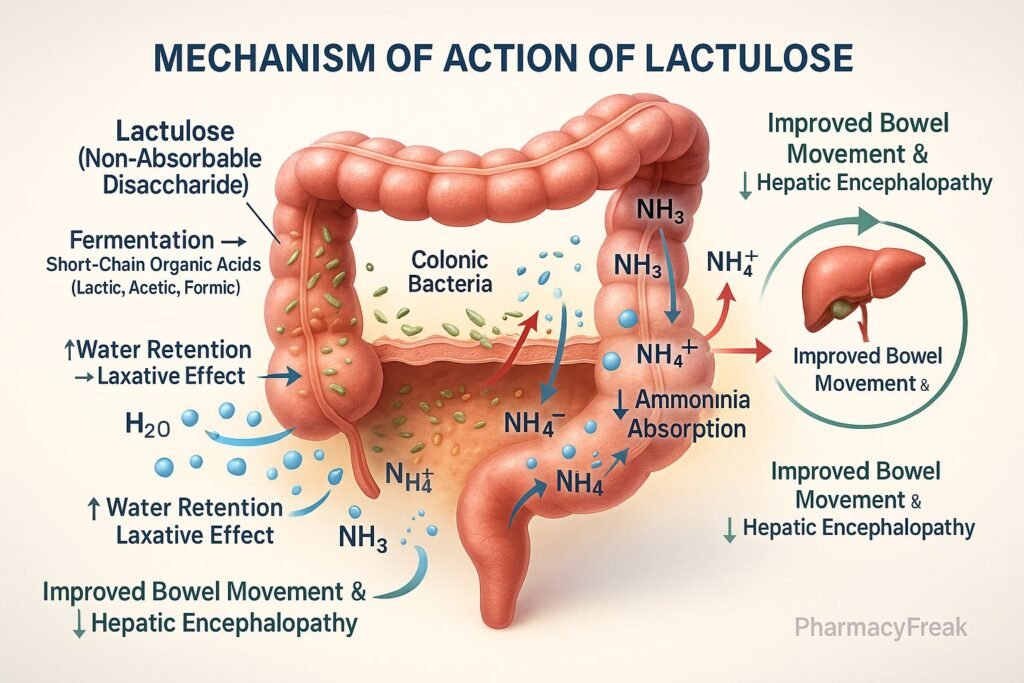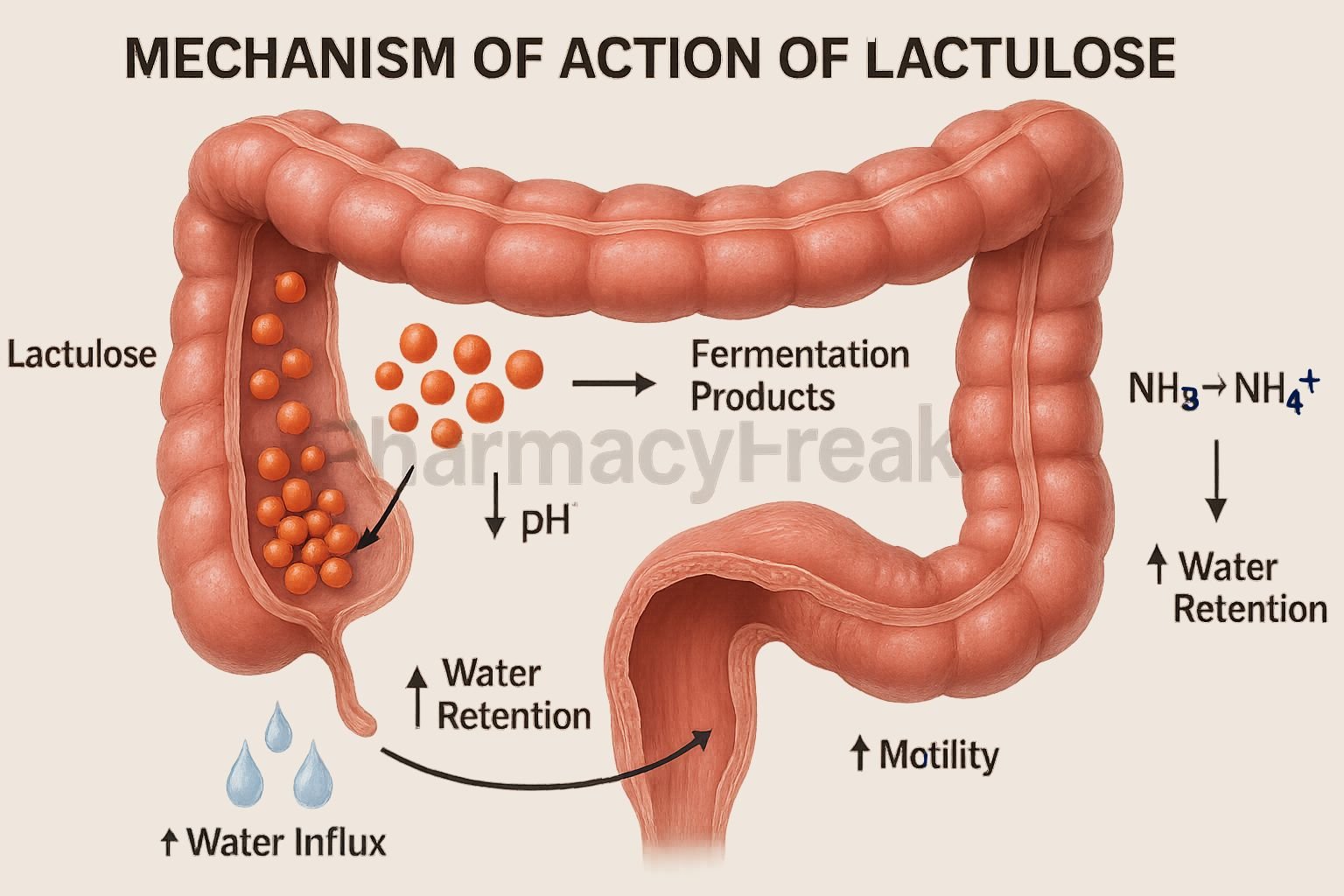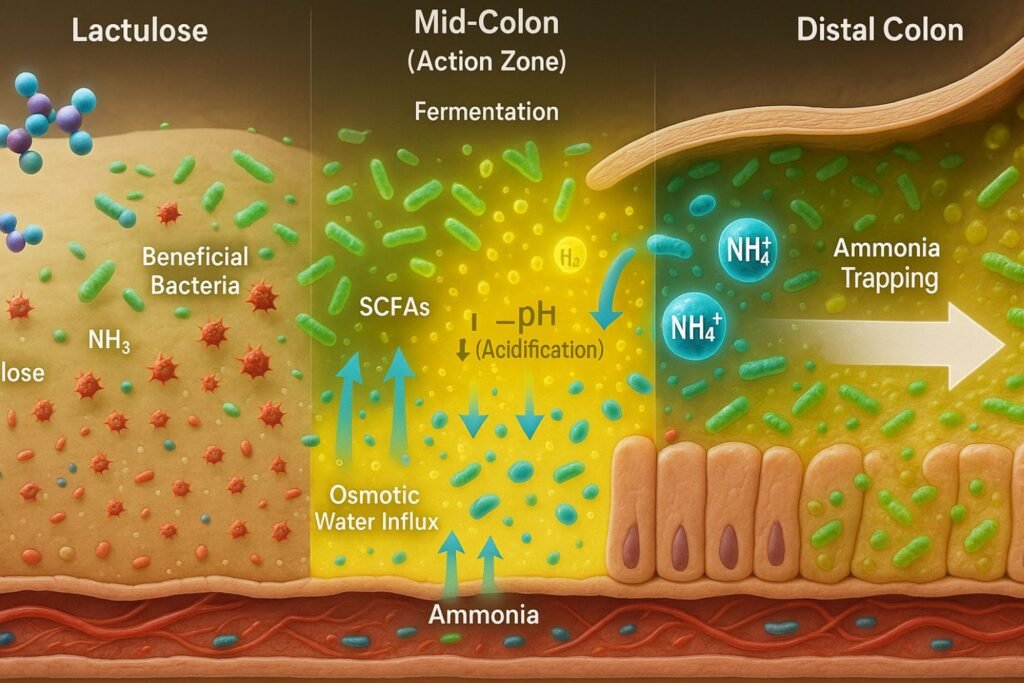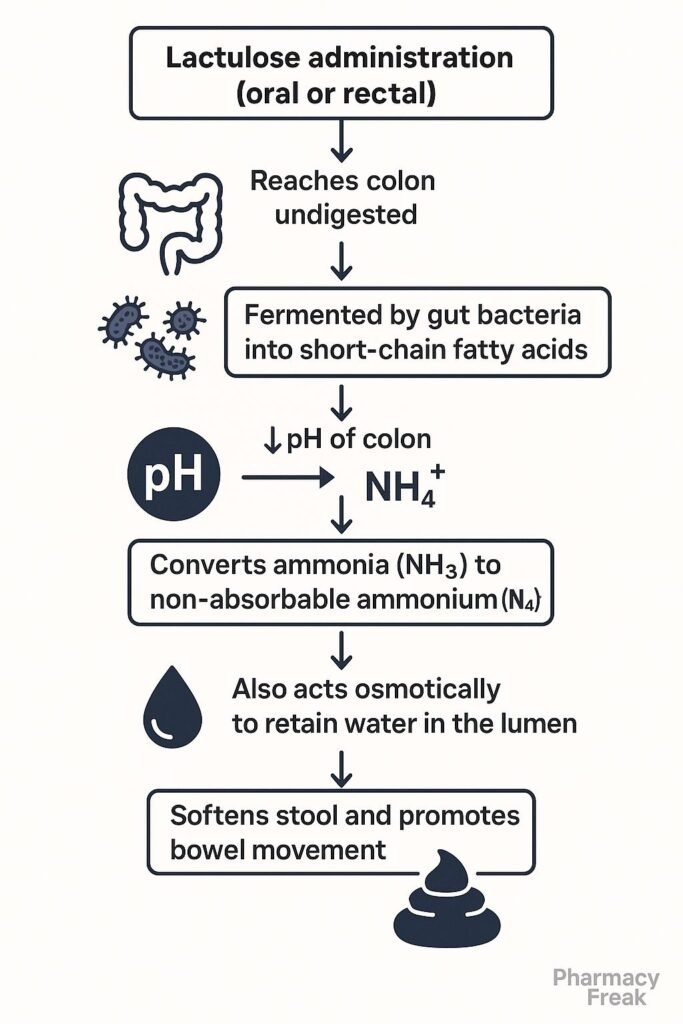Table of Contents
Introduction
Lactulose is a synthetic disaccharide used primarily for the treatment of hepatic encephalopathy and constipation. As a non-absorbable sugar, it exerts its effects locally in the colon through osmotic activity and modulation of gut flora. Its dual action—both osmotic laxative and ammonia-reducing agent—makes it a unique therapeutic agent in hepatic and gastrointestinal conditions.
Mechanism of Action (Step-wise)



1. Passage to Colon Without Absorption
Lactulose is not digested or absorbed in the small intestine, allowing it to reach the colon unchanged.
2. Fermentation by Colonic Bacteria
In the colon, lactulose is fermented by resident bacteria to form short-chain fatty acids (SCFAs) such as lactic acid and acetic acid.
3. Osmotic Effect and Water Retention
The resulting acidic environment increases osmotic pressure, drawing water into the lumen and softening stool, leading to bowel movements.
4. Acidification of Colonic Contents
SCFA production lowers colonic pH, which converts diffusible ammonia (NH3) into non-diffusible ammonium ions (NH4+).
5. Ammonia Trapping and Excretion
This reduces serum ammonia levels, beneficial in hepatic encephalopathy where ammonia accumulation leads to neurotoxicity.
6. Promotion of Non-urease Producing Flora
Lactulose favors the growth of non-urease producing bacteria, further decreasing ammonia generation.

Pharmacokinetics
- Route of Administration: Oral or rectal
- Absorption: Not absorbed in the small intestine
- Onset of Action: 24–48 hours (oral), faster rectally
- Metabolism: Colonic bacterial fermentation
- Excretion: Fecal (major), negligible systemic presence
Clinical Uses
- Hepatic encephalopathy (to reduce serum ammonia)
- Chronic constipation
- Portal systemic encephalopathy
- Bowel preparation (off-label)
Adverse Effects
- Flatulence
- Abdominal cramping
- Bloating
- Diarrhea (especially in high doses)
- Electrolyte imbalances (long-term use)
- Contraindications: Galactosemia, intestinal obstruction
Comparative Analysis
| Parameter | Lactulose | Polyethylene Glycol (PEG) |
|---|---|---|
| Class | Osmotic laxative | Osmotic laxative |
| Main Indication | Hepatic encephalopathy, constipation | Constipation, colonoscopy prep |
| Absorption | Not absorbed | Not absorbed |
| Electrolyte Disturbance | Possible | Minimal |
| Onset (Oral) | 24–48 hours | 1–4 hours |
Multiple Choice Questions (MCQs)
1. Lactulose is fermented in the colon to produce:
a) Amino acids
b) Ketone bodies
c) Short-chain fatty acids
d) Glucose
Answer: c) Short-chain fatty acids
2. What is the mechanism by which lactulose reduces ammonia levels?
a) Enhancing renal excretion
b) Increasing bile flow
c) Trapping ammonia as ammonium ion
d) Inhibiting urease enzyme
Answer: c) Trapping ammonia as ammonium ion
3. The onset of oral lactulose action is typically:
a) 1–2 hours
b) 4–6 hours
c) 12–24 hours
d) 24–48 hours
Answer: d) 24–48 hours
4. Which of the following is a common side effect of lactulose?
a) Bradycardia
b) Flatulence
c) Hypotension
d) Rash
Answer: b) Flatulence
5. Lactulose is contraindicated in:
a) Hepatic encephalopathy
b) Galactosemia
c) Portal hypertension
d) Hemorrhoids
Answer: b) Galactosemia
FAQs
Q1. Can lactulose be used in children?
Yes, it is commonly used in pediatric constipation and hepatic encephalopathy under medical supervision.
Q2. Is lactulose safe during pregnancy?
Generally considered safe but should be used under physician guidance.
Q3. Does lactulose require any dietary restrictions?
High-fiber diets may complement its action, but no specific restrictions are usually needed.
Q4. Can lactulose cause dependency?
Unlikely, but long-term use should be monitored.
Q5. How is rectal lactulose used?
In hepatic encephalopathy, it can be administered as a retention enema for quicker action.
References
- Goodman & Gilman’s The Pharmacological Basis of Therapeutics, 12th Edition
- KD Tripathi, Essentials of Medical Pharmacology, 7th Edition
- Lactulose Prescribing Information
- Clinical guidelines for hepatic encephalopathy and constipation
Related Internal Links

I am pursuing MBA in pharmaceutical management from NIPER Hyderabad with a strong academic record and proven success in national-level pharmacy entrance exams. I secured AIR 61 in NIPER 2024 (MS/M.Pharm) and AIR 27 in NIPER MBA, along with AIR 147 in GPAT 2024 and AIR 907 in GPAT 2023. I also achieved AIR 6 in AIIMS CRE-2025 for Drug Store Keeper and was selected as a Pharmacist (AIR 61) for ESIC. Additionally, I was the Runner-Up in Round 2 of the EY Case Study Competition.
At PharmacyFreak.com, I aim to guide future pharmacists through expert content, exam strategies, and insightful resources based on real experience and academic excellence.
Mail- harsh@pharmacyfreak.com
